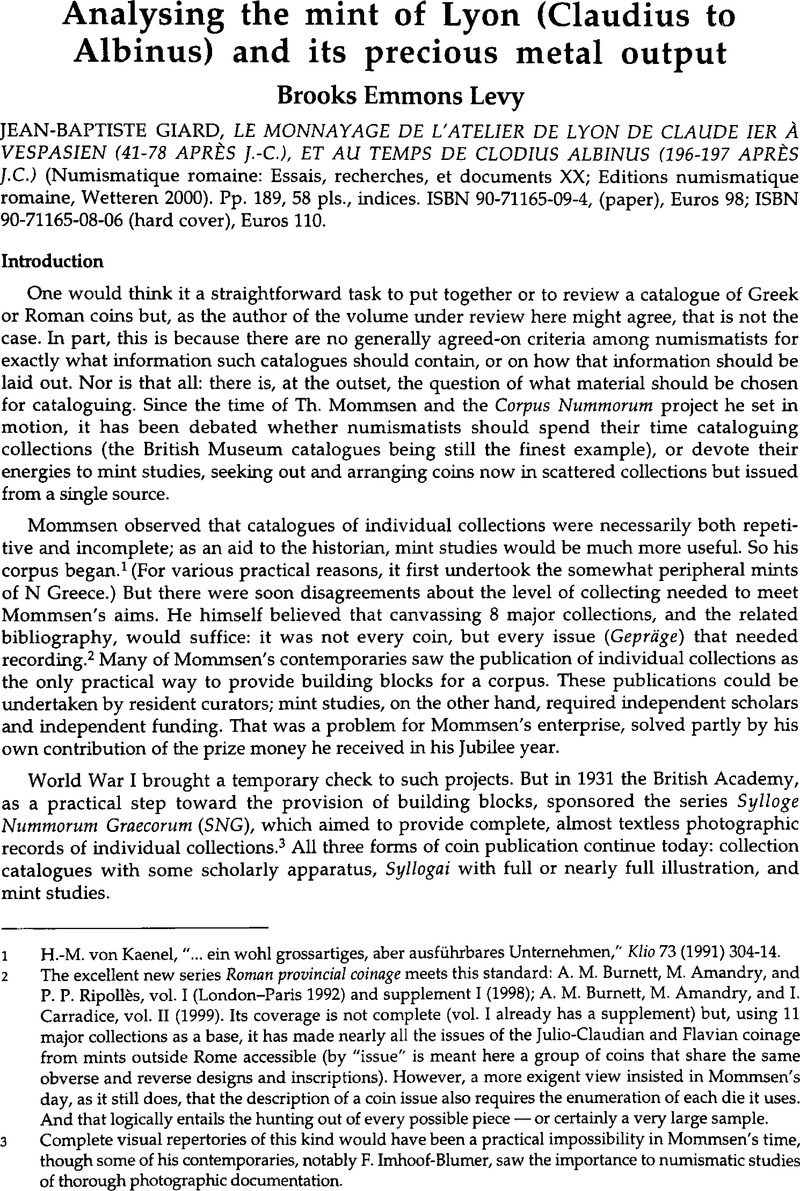No CrossRef data available.
Article contents
Analysing the mint of Lyon (Claudius to Albinus) and its precious metal output - Jean-Baptiste Giard, LE MONNAYAGE DE L'ATELIER DE LYON DE CLAUDE IER À VESPASIEN (41-78 APRÈS J.-C.), ET AU TEMPS DE CLODIUS ALBINUS (196-197 APRÈS C.) (Numismatique romaine: Essais, recherches, et documents XX; Editions numismatique romaine, Wetteren 2000). Pp. 189, 58 pls., indices. ISBN 90-71165-09-4, (paper), Euros 98; ISBN 90-71165-08-06 (hard cover), Euros 110.
Published online by Cambridge University Press: 16 February 2015
Abstract

- Type
- Reviews
- Information
- Copyright
- Copyright © Journal of Roman Archaeology L.L.C. 2002
References
1 von Kaenel, H.-M., “… ein wohl grossartiges, aber ausführbares Unternehmen,” Klio 73 (1991) 304–14Google Scholar.
2 The excellent new series Roman provincial coinage meets this standard: Burnett, A. M, Amandry, M., and Ripollès, P. P., vol. I (London-Paris 1992) and supplement I (1998)Google Scholar; A. M. Burnett, M. Amandry, and I. Carradice, vol. II (1999). Its coverage is not complete (vol. I already has a supplement) but, using 11 major collections as a base, it has made nearly all the issues of the Julio-Claudian and Flavian coinage from mints outside Rome accessible (by “issue” is meant here a group of coins that share the same obverse and reverse designs and inscriptions). However, a more exigent view insisted in Mommsen's day, as it still does, that the description of a coin issue also requires the enumeration of each die it uses. And that logically entails the hunting out of every possible piece — or certainly a very large sample.
3 Complete visual repertories of this kind would have been a practical impossibility in Mommsen's time, though some of his contemporaries, notably F. Imhoof-Blumer, saw the importance to numismatic studies of thorough photographic documentation.
4 Fischer-Bossert, W., Chronologie der Didrachmenprägung von Tarent 510-280 (AMuGS 14, 1999)Google Scholar.
5 See Metcalf, W. E., “Roman dies in modern studies,” in Doty, R. and Hackens, T. (edd.), Italiani fato profiigi (Louvain-la-Neuve 1996) 253 ffGoogle Scholar.
6 Burnett, A. M., “Catalogues, coins, and mints,” JRS 68 (1978) 174 Google Scholar.
7 “La moneta di conto nel Medioevo,” RIN 95 (1993) 614 Google Scholar. See too Buttrey, T. V., “Calculating ancient coin production I,” NC 153 (1993) 335–51Google Scholar; “Calculating ancient coin production II,” NC 154 (1994) 341–52Google Scholar.
8 Giard's discussion of the term “émission” may be found in Lyon 1, 20–24 Google ScholarPubMed.
9 Today, however, the best auction catalogues feature direct photos, so illustration exclusively from casts (fine old collotype plates always excepted) begins to look a little quaint.
10 Crawford, M., TLS 1984, 950 Google Scholar.
11 von Kaenel, H.-M., Münzprägung and Münzbildnis des Claudius (AMuGS 9, 1986)Google Scholar.
12 Even von Kaenel was criticized by a reviewer ( Clay, C., NC 151 [1991] 258 Google Scholar) for illustrating only about 50% of the total Claudian material he had collected: 1694 dies shown out of 3035 listed. Giard in Lyon II refers to von Kaenel's effort, but rather obliquely: “Il suffit donc de reprendre ce travail…” (28).
13 Place of origin is not a problem with most Late Imperial issues of Lyon, clearly mintmarked.
14 Her update with later bibliography appeared in that catalogue's third volume (1977).
15 Most recently by Wolters, R., Nummi signait (Vestigia 49, Munich 1999) 79–83 Google Scholar; with a revised arrangement for Claudius' precious metal issues, 61-79.
16 “Rome and Lugdunum again,” AJN 1 (1989) 51–70 Google Scholar.
17 Millar, F., “Les congiaires à Rome et la monnaie,” in Giovannini, A. (ed.), Nourrir la plèbe (Basel 1991) 146 Google Scholar.
18 Noted but not discussed by Mattingly, Sutherland, and MacDowall; also by Bergmann, M., Die Strahlen der Herrscher (Mainz 1998) 174, 231 Google Scholar.
19 RevNum 1976, 69 Google Scholar.
20 “The bronze coinage of Vespasian: classification and attribution,” in Carson, R. A. G. and Kraay, C. (edd.), Scripta niimmaria romana (London 1978) 56 Google Scholar.
21 Clay, C., “Roman Imperial medallions: the date and purpose of their issue,” in Cahn, H. A. and Rider, G. Le (edd.), Proc. 8th int. Numismatic Congress (Paris 1976) 264–65Google Scholar.
22 For a comparable case see Buttrey, T.V., “The denarii of Pescennius Niger,” NC 152 (1992) iv–xxii Google Scholar.
23 A new variant on the reverse type of Giard's no.21 has appeared since Lyon II was published: CNG 54 (06 2000) no. 1666Google Scholar.




